IoT And Blockchain - Automation and Reliability
Today, most everyone knows what blockchain is and how it approximately works. The number of projects based on this prominent tech concept is growing exponentially (statistics indicate that in 2018, $1.5 billion was invested in blockchain-based solutions, and by 2022 this figure will increase to $11.7 billion).
And, despite a large number of scammers with their crowdfunding cons, it is quite difficult to overestimate the importance of blockchain in the global software development industry. In this article, we take a look at particular use cases and discuss the symbiosis of blockchain and IoT - two outstanding, hugely promising tech concepts to transform the world as we know it.
IoT and Blockchain — Brief Definition of Terms
Before diving into real use cases of blockchain in IoT and vice versa, let's briefly outline the definitions of these two terms.
Thus, as comes from its name, a blockchain is a chain of blocks, each of which is marked by the time of its creation, by a link to the previous block, and is stored on a separate physical medium. This allows for implementing a serverless architecture. On top of that, the application of modern encryption algorithms allows you to protect individual records belonging to a specific person from copying/editing by other users of the centralized system.
A system that has blockchain in its core works in the following manner:
- an initial block with no previous block records is created;
- every subsequent block holds info about the previous block, about the type of data stored, and about the title for the generation of another block;
- despite the fact that all system users can see a number of all existing blocks, they can only access blocks they created personally.
All in all, a developer of a blockchain-based system gets four super useful elements:
- consensus, which confirms the actions of users in the network (the most popular examples are Proof-of-Work or Proof-of-Stake);
- ledger, which displays all the transactions taking place in the network;
- encryption, which guarantees the security of transferred and stored data;
- smart contracts, which are used for network participants’ authorization.
Despite the fact that many of us associate the blockchain with bitcoin (in fact, bitcoin became the first public implementation of the blockchain), this technology can be applied in a huge scope of directions, including the IoT niche.
Learn how blockchain is shaping the future of music distribution
As for the IoT or the Internet of Things, this term describes several concepts efficiently combined into one tech concept: a set of interconnected devices (things) governed by a centralized network, the Machine-to-Machine connection format implemented without human intervention, and the big data that these devices generate and process.
Together, blockchain and IoT are able to tailor reliable, safe, and user-friendly solutions for organizing and processing data coming from Internet-compatible devices. Let’s go into more detail.
Blockchain In IoT — Use Cases & Options
The joint use of the blockchain and IoT is a handy way to go if you need to guarantee the security and invariance of the data in your project. Described below are some typical deployment scenarios for blockchain IoT applications.
Ultra-reliable local network data transfer solutions
Let’s kick off the list of prominent blockchain and IoT use cases with a solution from Filament. The company developed the TAP device, which allows you to deploy a secure wireless network for the Internet of Things and collect data from sensors in a metropolis.
Devices communicate with each other at a distance of 15 km, and the blockchain allows them to exchange data using smart contracts. In the future, such solutions can find application in organizing ultra-secure communications at military bases, in scientific towns, and other locations where it is not possible to use Wi-Fi with traditional encryption protocols for wireless traffic.
Quality assurance solutions
In 2015, a globally-renowned IBM corporation, in collaboration with the global technology giant Samsung, introduced the ADEPT project — an autonomous decentralized peer-to-peer telemetry network.
This system forms a distributed network of IoT devices, using which network operators or users can receive any captured data (this can be data about any difficulties in the operation of the devices themselves or the devices to which they connected). In addition, ADEPT is able to cope with a number of problems on its own - for example, download software updates or reboot/restart the system when need be.
Case Studies: Mustang Chain

In general, such solutions can provide end-to-end automation when taking vital system readings (this can be useful in agriculture, animal breeding, manufacturing, and even in some completely digital structures). With a blockchain powered by the IoT-based equipment, you can get a single database with the information you need that is:
- 100% authentic;
- protected from unauthorized access;
- is updated in real time.
For another thing, due to the lack of the need to use additional nodes (for example, network administrators who are responsible for maintaining network performance in centralized structures), it will help you save the costs of operating the created solution as a whole (and, of course, minimize human factor risks).
Logistics & supply chain optimization solutions
Last but not least in this brief list of standing-out blockchain applications in IoT are solutions for optimizing supply chain and logistics processes. One of the world-renowned logistics companies, Maersk, recently announced a collaboration with IBM to work on the TradeLens project — a global open-source blockchain-based platform that can track shipments in real time.
It is worth noting that despite the numerous artificial intelligence-based solutions that have expanded the logistics industry in the past few years, manufacturers of goods still suffer losses due to non-compliance with transportation conditions, substitution of counterfeit original goods, delays on flights, returns, etc.
Let’s create something remarkable together
Add the ever-relevant issue of transporting perishable products to all this and it becomes clear that logistics practices of the now clearly require additional technological optimizations.
In turn, solutions based on IoT and blockchain can reduce the risks associated with the transportation of goods and, ultimately, increase your profits. So, instead of involving several intermediaries at points of goods transfer, you can simply use smart contracts.
This, on the one hand, will protect your product from an unauthorized switcheroo, and on the other hand, will allow you to slightly lower the final price tag for the product, which will certainly please end consumers.
Blockchain IoT system development
If you have an idea to implement using the IoT and blockchain, we will be happy to offer you what we got. Our in-house developers have extensive experience of working on IoT-, blockchain-, and IoT-blockchain-based solutions. Thus, the latest and, perhaps, the most significant project, in the development of which we took part, was the Cecil Alliance platform, named after the lion Cecil that was sadly killed by poachers.
Its main goal is to allow people who are interested in preserving the environment and, in particular, animals, to monitor the condition of wildlife inhabitants in real time. To do this, an IoT sensor is implanted in the desired animal, and then, using the blockchain, all the collected data is transmitted and processed by the platform algorithms.
This is an ultimate way to eliminate data falsification in the matter, which also allows scientists and other people who care about animals to make sure that everything is in order with animals they care about (or vice versa, come to the rescue on time). Note that the platform solves the problem of tracking animals globally, which means that even pet owners can use it.

Blockchain Technology and IoT — Summary
As you can see, the synergy of blockchain technology and IoT is able to offer highly reliable solutions for the real world without the need for any intermediaries. Ultimately, this reduces the costs of production and operation, and guarantees a level of data security and reliability not previously available with any other centralized network. If you wish to discuss the details of your future project with us — feel free to contact us!
We handle any blockchain and IoT projects, as well as joint solutions based on in-depth related expertise, years of experience, and top-notch service standards.

Our team is dedicated to delivering high-quality services and achieving results that exceed clients' expectations. Let’s discuss how we can help your business succeed.


SHARE: